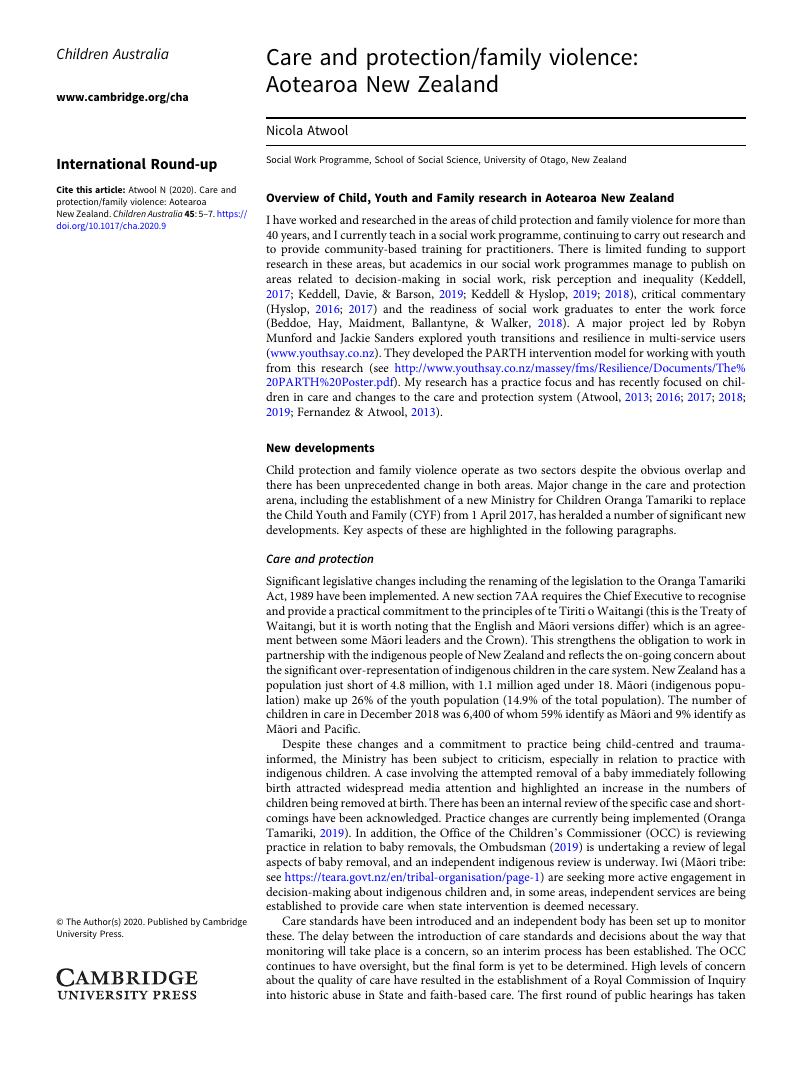No CrossRef data available.
Article contents
Care and protection/family violence: Aotearoa New Zealand
Published online by Cambridge University Press: 26 May 2020
Abstract
An abstract is not available for this content so a preview has been provided. Please use the Get access link above for information on how to access this content.

- Type
- International Round-up
- Information
- Copyright
- © The Author(s) 2020. Published by Cambridge University Press
References
Atwool, N. R. (2013). Birth family contact for children in care. How much? How often? Who with? Child Care in Practice, 19(2), 181–198.CrossRefGoogle Scholar
Atwool, N. R. (2016). Journeys of exclusion: Unpacking the experience of Adolescent care leavers in New Zealand. In Mendes, P. & Snow, P. (Eds.), Young people transitioning from out of home care (pp. 309–328). London: Palgrave.Google Scholar
Atwool, N. R. (2017). Life story work: Optional extra of fundamental entitlement? Child Care in Practice, 23(1), 64–76. doi: 10.1080/13575279.2015.1126228CrossRefGoogle Scholar
Atwool, N. R. (2018). Challenges of operationalizing trauma-informed practices in child protection in New Zealand. Child and Family Social Work. doi: 10.1111/cfs.12577Google Scholar
Atwool, N. R. (2019). Child-centred practice in a bi- and multi-cultural context: Challenges and dilemmas. Child Care in Practice. doi: 10.180/13575279.2018.1555140Google Scholar
Beddoe, L., Hay, K., Maidment, J., Ballantyne, N., & Walker, S. (2018). Readiness to practice social work in Aotearoa New Zealand: Perceptions of students and educators. Social Work Education, 37
(5), 955–967.CrossRefGoogle Scholar
Carne, S., Rees, D., Paton, N., & Fanslow, J. (2019). Using systems thinking to address intimate partner violence and child abuse in New Zealand. New Zealand Family Clearing House Issues paper 13. nzfvc.org.nz.Google Scholar
Family Violence Death Review Committee (2016). Fifth Report: January 2014 to December 2015. Wellington: Health and Quality Safety Commission.Google Scholar
Fernandez, E., & Atwool, N. R. (2013). Child protection and out of home care: Policy, practice and research connections Australia and New Zealand. Psychosocial Intervention, 22(3), 175–184.CrossRefGoogle Scholar
Herbert, R., & Mackenzie, D. (2014). The way forward: An integrated system for intimate partner abuse and child abuse and neglect in New Zealand. Wellington: The Impact Collective.Google Scholar
Hyslop, I. (2016). Where to social work in a brave new Aotearoa? Aotearoa New Zealand Social Work, 28(1), 5–12.CrossRefGoogle Scholar
Hyslop, I. (2017). Child protection in New Zealand: A history of the future. British Journal of Social Work, 47, 1800–1817.CrossRefGoogle Scholar
Independent Whānau Ora Review Panel (2018) Whānau Ora Review. Tipu Mataro kit e Ao. Final Report to the Minister for Whānau Ora. Wellington: Te Puni Kokiri.Google Scholar
Keddell, E. (2017). The vulnerable child in neoliberal contexts: The construction of children in child protection reforms. Childhood, 25(3), 90–108.Google Scholar
Keddell, E., Davie, G., & Barson, D. (2019). Child protection inequalities in Aotearoa New Zealand: Social gradient and the inverse intervention law. Children and Youth Services Review, 104, 104383.CrossRefGoogle Scholar
Keddell, E., & Hyslop, I. (2018). Role type, risk perception and judgement in child welfare: A mixed methods vignette study. Children and Youth Services Review, 57, 130–139.CrossRefGoogle Scholar
Keddell, E., & Hyslop, I. (2019). Ethnic inequalities in child welfare: The role of practitioner risk perceptions. Child and Family Social Work, 24(4),
4309–4420.CrossRefGoogle Scholar
Mossman, E., Wehipeihana, N., & Bealing, M. (2019). Evaluation of family violence Integrated Services Response Pilot. Final Report. Retrieved from https://www.justice.govt.nz/assets/Documents/Publications/nIG96VfM-I.Google Scholar
Ombudsman (2019). Systemic improvement investigation: Oranga Tamariki baby removal. Retrieved from https://www.ombudsman.parliament.nz/sites/default/files/2019-11/orangatamarikinewbornremovalinvestigation-termsofreference_0.pdf.Google Scholar
Oranga Tamariki (2019). Practice review. Retrieved from https://www.orangatamariki.govt.nz/assets/Uploads/News/2019/Practice-Review/Practice-Review.pdf.Google Scholar
Otago Youth Wellness Trust (2010). Holding hope. An evaluation of the Otago Youth Wellness Trust Wraparound Service. Dunedin, NZ: OYWT.Google Scholar
Shailer, J. L., Gammon, R. A., & de Terte, I. (2013) Youth with serious mental health disorders: Wraparound as a promising intervention in New Zealand. Australian and New Zealand Journal of Family Therapy, 34, 186–213. Retrieved from https//doi.org/10.1002/anzf.1028.CrossRefGoogle Scholar
Wilson, D., & Webber, M. (2014). The people's blueprint: Transforming the way we deal with child abuse and domestic violence in New Zealand. Auckland: The Glenn Inquiry.Google Scholar


